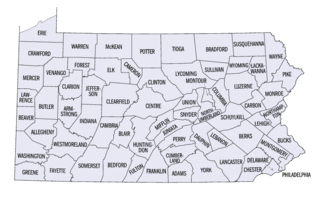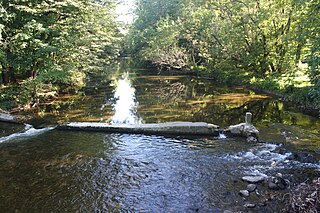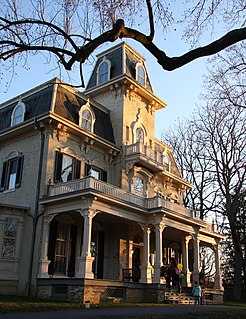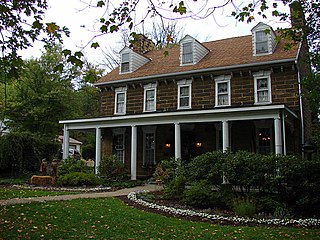
Bethlehem is a city in Lehigh and Northampton counties in the Lehigh Valley region of the eastern portion of the U.S. state of Pennsylvania. As of the 2010 census, the city had a total population of 74,982, making it the seventh largest city in Pennsylvania, after Philadelphia, Pittsburgh, Allentown, Erie, Reading, and Scranton. Of this, 55,639 were in Northampton County, and 19,343 were in Lehigh County.

Monocacy National Battlefield is a unit of the National Park Service, the site of the Battle of Monocacy in the American Civil War fought on July 9, 1864. The battlefield straddles the Monocacy River southeast of the city of Frederick, Maryland. The battle, labeled "The Battle That Saved Washington," was one of the last the Confederates would carry out in Union territory. The two opposing leaders were General Jubal Early, fighting for the South, and General Lew Wallace, fighting for the North.

This is a list of properties and districts listed on the National Register of Historic Places in Pennsylvania. As of 2015, there are over 3,000 listed sites in Pennsylvania. Sixty-six of the 67 counties in Pennsylvania have listings on the National Register; Cameron County is the only county without any sites listed.

Farmar Mill is a historic mill building. The mill was powered by the Wissahickon Creek and is located on Mather's Lane near Skippack Pike, and just west of the historic Bethlehem Pike in the village of Whitemarsh, Pennsylvania, in the United States.

Erdenheim is a community in Springfield Township, Montgomery County, Pennsylvania. It is served by the 19038 zip code. The primary commercial areas are located along Bethlehem Pike.

Saucon Creek is a 17.0-mile-long (27.4 km) tributary of the Lehigh River in Lehigh and Northampton Counties, Pennsylvania in the United States.

The Bethlehem Waterworks, also known as the Old Waterworks or 1762 Waterworks, is believed to be the oldest pump-powered public water supply in what is now the United States. The pumphouse, which includes original and replica equipment, is located in the Colonial Industrial Quarter of downtown Bethlehem, Pennsylvania, between the Monocacy Creek and Main Street. It was declared an American Civil Engineering Landmark in 1971, an American Water Landmark in 1971, and a National Historic Landmark in 1981. The building is a contributing property to the Historic Moravian Bethlehem Historic District which was designated as a National Historic Landmark District in 2012 and later named to the U.S. Tentative List in 2016 for nomination to the World Heritage List.

Gambrill House, also known as Boscobel House and Edgewood, is a house near Frederick, Maryland in the Monocacy National Battlefield. It was listed on the National Register of Historic Places in 1985.

Graceham Moravian Church and Parsonage is a historic church building and parsonage located at 8231 Rocky Ridge Road, MD 77 in Graceham, east of Thurmont, Frederick County, Maryland. It is a two-story Flemish bond brick church built in 1822, and covered with white stucco because of deteriorated masonry. The church was built as an addition to the adjacent meeting house and parsonage built in 1797. This building and the church's cemetery having uniform flat gravestones represents Maryland's only remaining 18th century Moravian settlement.

Creagerstown is an unincorporated community in Frederick County, Maryland, United States. It is playfully known by its residents as "4 miles from everywhere" because of its situation at 4 miles (6.4 km) from Thurmont, Woodsboro, Rocky Ridge, and Lewistown.

Hill's Tavern is a historic building in Scenery Hill, Pennsylvania. It was heavily damaged by a fire that started shortly before midnight on August 17, 2015. For a period in the early 1900s, the inn was known as Central Hotel. Now called the Century Inn, it has been claimed to have been the oldest tavern in continuous use on the National Road, until the fire brought an end to its 221 years of continuous operation.

The Knabb-Bieber Mill is located in Oley Township, Pennsylvania. The mill was built in 1809 and was added to the National Register of Historic Places on November 8, 1990.

The Tannery is a historic tannery building constructed by the colonial Moravians in Bethlehem, Northampton County, Pennsylvania. It is a limestone building built in 1761, and is part of the Bethlehem Colonial Industrial Quarter.

Gristmiller's House, also known as The Miller's House, is a historic home located at Bethlehem, Northampton County, Pennsylvania. The original building is a one-story limestone structure built in 1782. A 1 1/2-story brick addition in the Federal style was built in the 1830s. It is included as part of the Bethlehem Colonial Industrial Quarter.

Bethlehem Steel Lehigh Plant Mill #2 Annex, also known as Merchant Mill No. 2 and the Johnson Machinery Building, is part of the historic steel mill located in Bethlehem, within Northampton County and the Lehigh Valley, Eastern Pennsylvania.

Bethlehem Silk Mill is a historic silk mill complex located at Bethlehem, Northampton County, Pennsylvania. It was built in 1886, and expanded about 1896 and about 1901. The complex once consisted of a total of seven interconnected historic buildings that formed an open rectangular plan around two central courtyards. Some of the buildings have been demolished. All of the buildings were constructed of red brick with stone foundations.

Snyder Mill is a historic grist mill located on Monocacy Creek in Exeter Township, Berks County, Pennsylvania. The mill was built about 1780, and is a 1 1/2-story, banked stone building. It measures 26 feet by 50 feet, with a frame addition of 20 feet, 3 inches, by 25 feet 10 inches. It retains a wooden water wheel. The mill ceased operations in 1930.

Archibald Johnston was a mechanical engineer who, favored by Bethlehem Iron Company management and senior Bethlehem Steel Company president Charles M. Schwab, became president of Bethlehem Steel Company. He was subsequently appointed as first vice president of the Bethlehem Steel Corporation in charge of foreign sales. While first vice president, he led a municipal consolidation campaign to create the modern city of Bethlehem, Pennsylvania, from the boroughs of Bethlehem and South Bethlehem. As the first mayor of the newly incorporated city, he presided over the construction of the Hill to Hill Bridge as chairman of the Bethlehem Bridge Commission, significantly enlarged the city's area, extended paved streets, water mains, and municipal sewerage, and provided the city's first municipal park.

The Historic Moravian Bethlehem Historic District encompasses a complex of the oldest surviving buildings in Bethlehem, Pennsylvania. The National Historic Landmark District is a subset of the larger Central Bethlehem Historic District which is specifically focused on the early buildings constructed by the Moravians who settled the city in the 18th century. The district was designated a National Historic Landmark in 2012 for its unique assemblage of communal religious buildings and history. In 2016 it was named to the U.S. Tentative List for nomination to the World Heritage List.

The Colonial Industrial Quarter of Bethlehem, PA is considered America's earliest industrial park. Established by the colonial Moravians along the banks of the Monocacy Creek, the ten acre site contains historic buildings such as the 1762 Waterworks, 1761 Tannery, 1869 Luckenbach Mill, 1748/1834 Gristmiller's House, reconstructed 1764Springhouse and 1750Smithy, as well as ruins of the original 1749Pottery, 1752Butchery, 1765Oil Mill, and 1771 Dye House. This location was chosen to take advantage of a spring that supplied potable water and the power supplied by the Monocacy Creek's flow for the craftsmen and trades of early Bethlehem.























